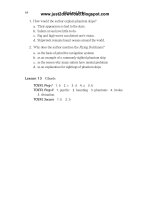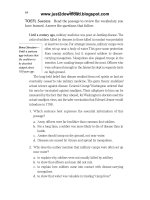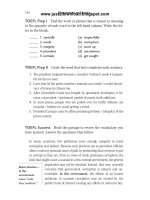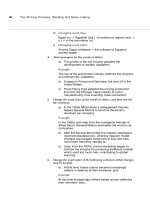Tài liệu Academic Writing A Handbook for International Students part 11 pdf
Bạn đang xem bản rút gọn của tài liệu. Xem và tải ngay bản đầy đủ của tài liệu tại đây (176.61 KB, 10 trang )
90
Elements of Writing
as the cosmopolitan lifestyle the city provides. Many
international students attend British universities. Most
welcome the chance to meet classmates from all over the
world, and all are pleased to have the chance to improve
their English. When he goes home to Shanghai, Li Pang
will have a network of international contacts to support his
future career.
4. Overgeneralising
This means making statements which are too simple or
inaccurate. For example, using income figures from the
table below, a writer might claim:
People were much richer in 1999 than 20 years earlier.
This ignores inflation over the period. It is more accurate
to say:
Average incomes in 1999 were nearly four times higher
than in 1979.
Changes in key economic indicators in the UK, 1979–1999
Britain 1979 1989 1999
Inflation rate 13.4% 7.8% 3.4%
Interest rate 12% 13.7% 5.5%
Unemployment 4.1% 6.1% 4.6%
Average income £5,000 £11,700 £19,000
Average house
price
£19,800 £61,500 £68,300
Each of the following contain overgeneralisation. Rewrite them
more accurately.
a) Between 1979 and 1999, the worst period for
unemployment was 1989.
b) Inflation fell steadily for 20 years after 1979.
c) There was a dramatic rise in house prices in these two
decades.
d) Interest rates peaked in 1989.
cross-reference
2.4 Comparisons
2.9 Numbers
2.8 Generalisations
91
5. Study the table below and complete the generalisations.
Regional population in 2000 and forecasts for 2100, with % over 60 years old
Region 2000 % over 60 2100 % over 60
N. America 314 16 454 40
W. Europe 456 20 392 45
S. Asia 1,367 7 1,958 35
S. America 515 8 934 33
N. Africa 173 6 333 32
a) By 2100, nearly half the population of W. Europe may
.....................................
b) The population of N. Africa may . .....................
.........................................
c) S. Asia and S. America both have ......................
........................................
d) W. Europe is likely to experience a .....................
........................................
e) By 2100, all these regions may ........................
..........................................
6. Read the text on ‘Dreams’ and write five generalisations using
the data.
A recent survey on dreams, completed by over 10,000
people, found that 68% of all dreams came into the
‘anxiety’ category. Being chased was the most common
dream, recorded by 72%. Dreams about falling (which
signify insecurity) are also very common, being recorded
by 70%.
55% have dreamed about relatives and friends who have
died. Many people believe that dreams can foretell the
future, but only 42% have experienced this type. 28% of
those surveyed have dreams about food, which seem to
occur during periods of weight watching, but 23% have
been pleased by dreams of finding money.
Example: Anxiety seems to be the cause of most dreams.
a) ..................................................
b) ..................................................
c) ..................................................
d) ..................................................
e) ..................................................
2.9 Numbers
1. Discussing statistical data is a necessary part of much
academic writing:
Approximately 1,800 children between the ages of 5 and
12 years were randomly selected . . .
Already 3% of the US working population (1.55 million)
are employed in 70,000 centres . . .
The earth’s atmosphere appears to be gaining 3.3 billion
metric tons of carbon annually . . .
. . . but five winters in the twentieth century were more
than 2.4°C colder than average.
Figures and numbers are both used to talk about statistical
data in a general sense.
The figures in the report need to be read critically.
Digits are individual numbers. Both fractions (
1
/
2
) and
decimals (0.975) may be used.
4,539 – a four-digit number
£225,000 – a six-figure salary(a number)
Figure (Fig.) 3 – Infant mortality rates in twelfth century
France (a diagram)
no final ‘s’ on hundred/thousand/million:
Six million people live in the region.
but: Thousands died in the last outbreak of cholera.
2. Percentages are commonly used for expressing rates of
change:
Overseas students in the university 2000–2003
2000 2001 2002 2003
200 300 600 1,000
Complete the following sentences about the table above with
percentages.
a) Between 2000 and 2001, the number of overseas students
increased by . .........%
b) The number increased by . .........% the following year.
c) Between 2000 and 2003 there was a ..........% increase.
3. Too many statistics can make texts harder to read. In some
cases, where the actual number is unimportant, words or
phrases may replace numbers to simplify the text:
Forty-three villages were cut off by the heavy snowstorm.
cross-reference
2.16 Visual Information
2.9 Numbers
93
Dozens of villages were cut off by the heavy snowstorm.
The following words or phrases can be used to describe
quantity.
Few students attended her lecture. (less than expected)
Several bodies have been discovered under the temple
floor. (3–4)
Various attempts were made to explain the symbols. (3–6)
Dozens of politicians attended the opening ceremony.
(30–60)
Scores of books are published every week. (50–100)
Rewrite the following sentences using one of the words or
phrases above.
a) Only four people responded to the questionnaire.
b) They received nearly 100 applications for the post.
c) She made five or six proposals to improve the team’s
performance.
d) He found over fifty factual errors in the article.
e) They made three or four drafts before writing the final
report.
4.
Study the following expressions, which are also used to simplify
statistics.
one in three a third/a quarter
twice (2s)/three times as many the majority/minority
a tenfold increase 50%, a percentage
to double/halve on average/the average
number
the most/least a small/large proportion
Rewrite each sentence in a simpler way, using one of the
expressions above.
94
Elements of Writing
a) Of the 415 people interviewed, 308 said that they
supported the president.
b) Last year the number of students on the course was
twenty-four, the year before it was twenty and this year it
is twenty-two.
c) In 1965 a litre of petrol cost 10p, while the price is now 80p.
d) Out of eighteen students in the group, twelve were
women.
e) The new type of train reduced the journey time to Madrid
from 7 hours to 3 hours 20 minutes.
f) Fifteen of the students studied law, eight finance and three
engineering.
g) The numbers applying to this department have risen from
350 last year to 525 this year.
5.
Rewrite the following sentences to present the data in a simpler
way.
a) The population of the European part of the former Soviet
Union is declining rapidly. It is forecast to fall by 18 m to
220m in 2025, and to drop to 140m by 2100.
Example:
The population of the European part of the former Soviet
Union is forecast to fall by nearly 10% by 2025, and by
nearly 40% by the end of the century.
b) The numbers of visitors to the temples show a remarkable
pattern. In 1998 just 40,000 made the journey, 83,000 in
1999 and 171,000 in 2000.









